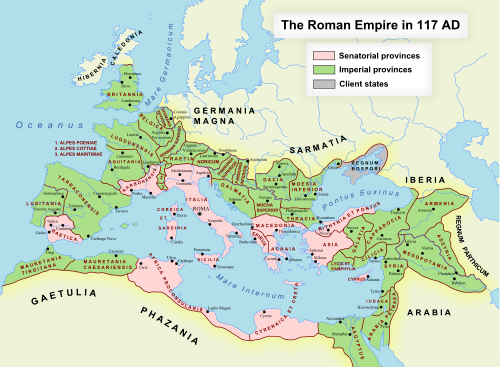Sophene
| Sophene Ծոփք Provincia Sophene | |||||
| Province of Greater Armenia | |||||
| |||||
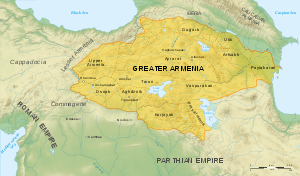 | |||||
| Capital | Carcathiocerta, later Arshamashat | ||||
| History | |||||
| • | Artaxias I declaring himself independent | 189 BC | |||
| • | Included in the province of Armenia | 530 AD. Area = 350 000 Km 2 | |||

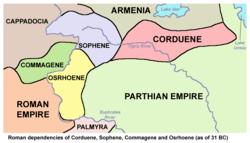
Sophene (Armenian: Ծոփք Tsopkh, Ancient Greek: Σωφηνή, translit. Sōphēnē or Armenian: Չորրորդ Հայք, English: Fourth Armenia) was a province of the Armenian Kingdom and of the Roman Empire, located in the south-west of the kingdom. The region lies in what is now southeastern Turkey.[1]
The region that was to become Sophene was part of the kingdom of Ararat (Urartu) in the 8th-7th centuries BC. After unifying the region with his kingdom in the early 8th century BC, king Argishtis I of Urartu resettled many of its inhabitants in his newly built city of Erebuni (modern day Armenian capital Yerevan). Around 600 BC, Sophene became part of the newly emerged ancient Armenian Kingdom of the Orontids. This dynasty acted as satraps of Armenia firstly under Median Empire, later under Persian Empire.
According to Anania Shirakatsi's Ashkharatsuyts ("World Atlas," 7th century), Tsopk (Sophene) was the 2nd among the 15 provinces of Greater Armenia. It consisted of 8 cantons (gavar):[2]
- Khordzyan
- Hashtyank
- Paghnatun
- Balahovit
- Tsopk Shahunyats
- Andzit
- Degik
- Gavrek
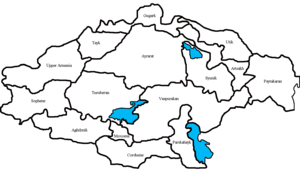
After Alexander the Great's campaigns in 330s BC and the subsequent collapse of the Achaemenid Empire, Sophene remained part of the newly independent kingdom of Greater Armenia. In the early 3rd century BC, at the instigation of the Seleucid Empire, which was trying to weaken the Armenian kingdom, Sophene, split from Greater Armenia, forming the Kingdom of Sophene. The kingdom was ruled by a branch of the Armenian royal dynasty of Orontids. Sophene later split from the Sophene-Commagene kingdom as well, forming an independent kingdom. Commagene was part of Sophene at this time.
Around 200 BC, in his attempt to finally subjugate Armenia, Seleucid king Antiochus III conquered both Greater Armenia and Sophene, installing Armenian generals Artaxias I and Zariadres as governors-strategoi in the respective kingdoms. Following Antiochus' defeat by the Romans at the battle of Magnesia in 190 BC, both Zareh and Artashes declared themselves independent kings. Zareh and his descendants ruled the kingdom of Sophene until it was reunified with Greater Armenia by Tigranes the Great in the 80s BC.
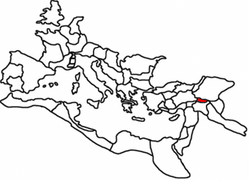
Pompey gave Sophene to Tigranes, after defeating his father Tigranes the Great.[3] Sophene later become part of the Roman Empire, and was made into a province of the Roman Empire. The capital was Amida (modern Diyarbakır). Around 54, the province was ruled by Sohaemus of Emesa.[4]
In 530, Sophene was included into the province of Armenia IV.[5]
The local Armenian population remained until the Armenian Genocide of 1915.[6]
See also
References
- ↑ The History of Rome By Theodor Mommsen, William Purdie Dickson.
- ↑ Anania Shirakatsi, Geography.
- ↑ Richardson, Peter, Univ of South Carolina Press, 1996, p. 96.
- ↑ Swain, Simon, Hellenism and Empire: Language, Classicism, and Power in the Greek World, Ad 50-250, Oxford University Press, 1996, p. 304.
- ↑ Joshua, The Chronicle of Pseudo-Joshua the Stylite, Liverpool University Press, 2001, p. 54.
- ↑ Armenian Soviet Encyclopedia
